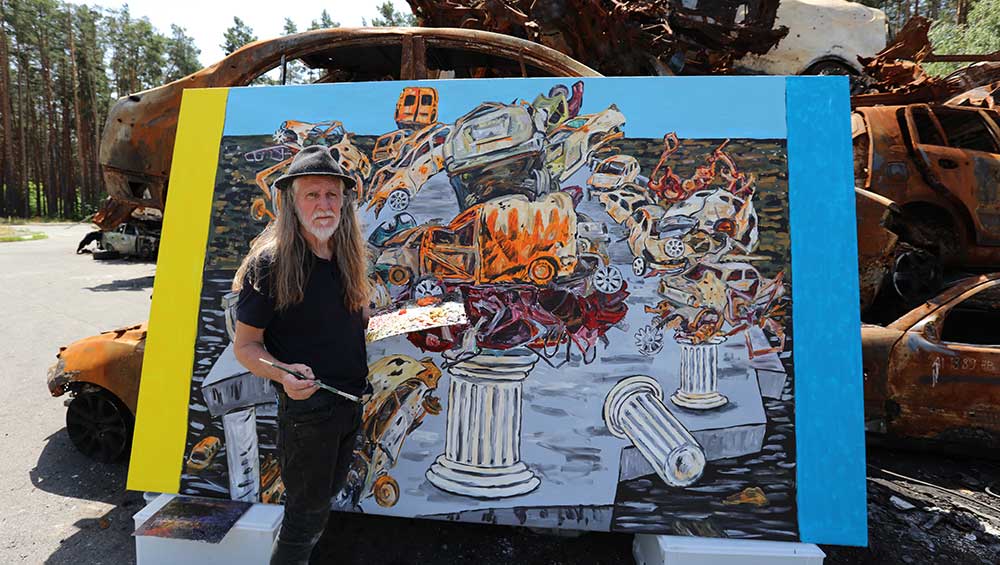
George Gittoes, painting outside in Bucha, Ukraine, 2022. © the artist.
by JANET McKENZIE
On 11 March 2022, the Australian artist and film-maker George Gittoes, with his wife, the singer and performer Hellen Rose, left Australia for Ukraine to film the impact of the war on local residents, and to create a large “peace mural” on the Central House of Culture in Irpin. Following the virtual destruction of the building that month, they extended their remit to relaunch the centre, asserting the seminal value of art and culture in wartime. Their self-funded trip aimed to create art in support of the besieged Ukrainian population, irrespective of the danger they would inevitably be putting themselves in. Other artists travelled to Ukraine, including Banksy, who was there in November 2022.
Working across media from documentary film to painting and performance art, Gittoes, 73, and Rose took five video cameras to share with young film-makers there, many of whom had joined the Ukrainian military response. They aimed to bring their skills as artists and communicators “to help a lot of young film-makers and artists learn how to make their voice heard and to reach the world”. In an interview in May 2022, they said: “One of the most powerful works we have created here was simply the photograph of a little girl’s party dress that was hanging in the blown-apart window of a home, a humble apartment in the towers burned and blown to pieces by the Russians in Borodyanka. We sent this image to our friends in the Australian band Midnight Oil, who are doing a huge international tour … in front of giant arena crowds. The simple image cuts through any language and anyone’s understanding of what is right and what is wrong.”1
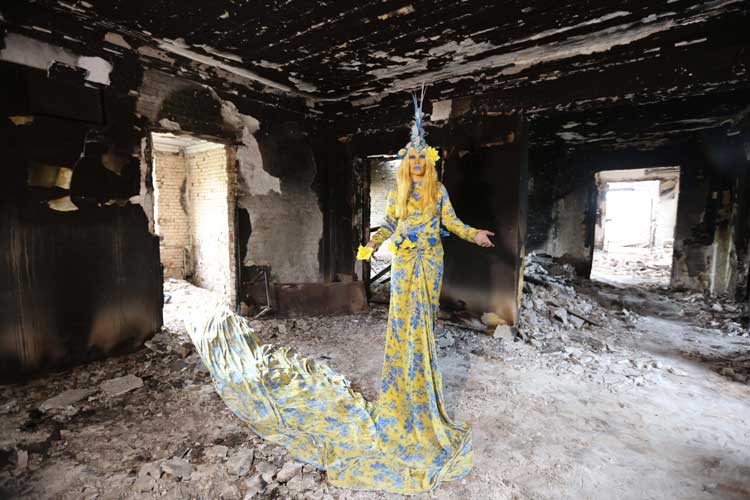
Hellen Rose, performance at Central House of Culture, Irpin. Ukrainistan film still, 2022. © the artist.
Of their film, Ukraine Guernica Artist War, Gittoes and Rose say: “[It] is about artists waging a war on war in the context of the Russian invasion of Ukraine, and Afghanistan, after the withdrawal of foreign forces [there]. It is an anti-war film in the tradition of Picasso’s Guernica and John and Yoko’s War Is Over. The process of creation is carefully followed in the face of the destruction witnessed by the artists [first-hand]. Dual projects are completed at the destroyed House of Culture in Irpin, Ukraine, and at the Yellow House Art School in Jalalabad.” Afghanistan has a common history with Ukraine as it, too, was invaded by Russia; the Russians in Afghanistan killed 2 million people between 1979 and 1989. Although Ukraine Guernica Artist War includes harrowing episodes, the film exudes Gittoes and Rose’s optimism that “humanity can end violent conflict and embrace peace through creativity”.
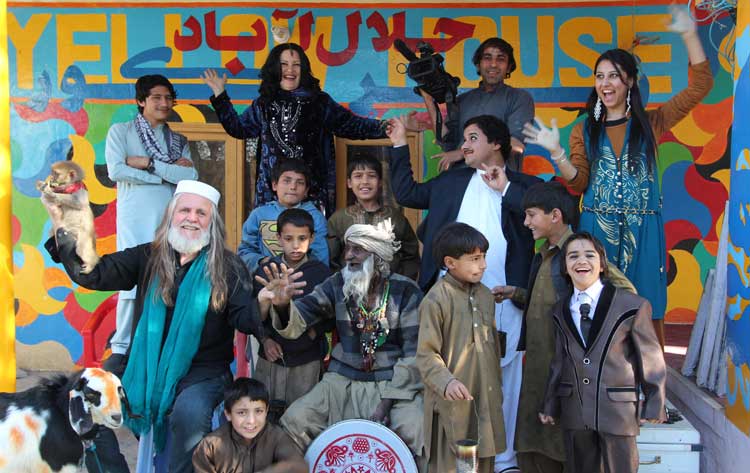
The Yellow House, Jalalabad. © the artist.
In Sydney, in 1970, George Gittoes (b1949) established The Yellow House, an experimental cooperative, with Martin Sharp and Brett Whitely. He has repeated the same concept in conflict-torn cities around the world, committed as he is to helping in humanitarian disasters that have taken place in war zones. He told The National in 2010: “The role of artists is to heal people, like shamans. [In war,] we have a role on the front line. It is important to create in the face of destruction and to let people know that you care and to be there, with them … Once you are involved you get beyond fear.”2 With Rose, he has travelled and worked in Afghanistan, where together they established the most recent iteration: The Yellow House, Jalalabad with media workshops for women, a sound studio and travelling circus tent.
Rose says: “As artists … the actual creation, collaboration and execution of the work is an extraordinary process that aims invisible golden arrows of energy towards ending this war. I have written several songs here that I am recording long distance with my band, Soul Crime, but I thought it would be great to have Viktor Solodchuk write a poem in Ukrainian that is a type of ‘spell’, fitting with the ancient tribal magic/ritual of my people of Europe and with the traditions and direct connections here in Ukraine. I will also sing Je Crois Entendre Encore from Bizet’s The Pearl Fishers. It’s a song for Leila, a priestess … [whose] job is to sing and pray all night to calm the demons of the deep and to ward off the spirits of the storm.”3
Gittoes has been travelling to war zones for 50 years. In each, he sets up a studio recording the activity in drawings, paintings, photography and film. He has worked in situ in almost every war zone since Vietnam: Cambodia, Nicaragua, the Philippines, Somalia, South Africa, Rwanda, Mozambique, the Western Sahara, Southern Lebanon, Palestine-Israel, Tibet, East Timor, Bougainville, Northern Ireland, the Republic of the Congo, Yemen, Iraq, the North-West Frontier of Pakistan and Afghanistan, and has become an award-winning film-maker and public artist. In 2010, Studio International interviewed the artist in Berlin and examined his complex and layered Descendence series, in which he explores, not only the physical destruction of war but also the immediate and long-term effects on the psyche, the soul and entire nations.
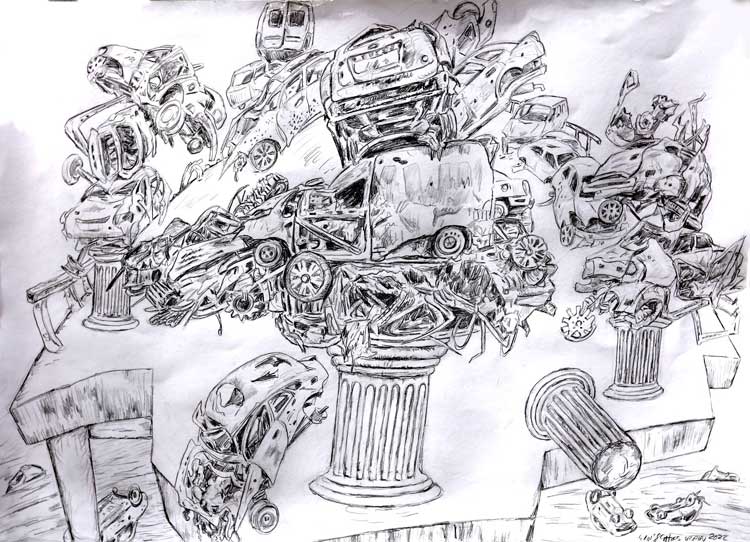
George Gittoes, Bridge of Death, Irpin, 2022. Pencil on paper, 84 x 60 cm. © the artist.
Gittoes’ response is always personal, and he has tended to the victims of war in dangerous positions. He has borne witness to genocide and ethnic cleansing in Bosnia and Rwanda. In Nicaragua, in 1987, he made The Bullets of the Poets, a film about the female Sandinista poets who took up guns against the dictator Somoza. The immediacy of the drawn image is Gittoes’ most incisive language and through it he seeks to reveal inner lives and psychological conflict, as well as making a record of the actual conflict of war. His work is firmly rooted in the tradition of Albrecht Dürer, Francisco Goya, Matthias Grünewald, El Greco, Käthe Kollwitz, Max Beckmann and Otto Dix. He has collaborated with many artists, including Leon Golub, Nancy Spero and Carolee Schneemann, who share the same anti-war message. But he says: “I spend much more time watching films than reading about artists or visiting great art in museums. Francis Ford Coppola’s film Apocalypse Now had a greater influence on the direction my art took than any contemporary painter.”4 He says: “Going to Ukraine was like travelling back in a time machine to join with the German expressionists.”
Gittoes interests are many and varied, including time travel, comic books – most recently Russian ones – robots and crash dummies and classical mythology. He also has extensive knowledge of the equipment and methodology of the armies he has accompanied as an independent witness to conflict zones in the 90s and post-9/11. In 2015, he was awarded the Sydney Peace Prize “for his courage to witness and confront violence in the war zones of the world”.
Janet McKenzie: You were at home at Werri Beach, in New South Wales, when Vladimir Putin’s forces invaded Ukraine. How did you make a plan and get into the country at a time of catastrophic events, not least the massive exodus of Ukrainian citizens?
George Gittoes: We had just returned from Peshawar in Pakistan and were working on editing video footage from our Afghan Yellow House Project when the news of the Russian invasion came about. Our plan was to return to Afghanistan and make a film about the impact of the American withdrawal and our hope that the Yellow House could continue under Afghan rule. We had been in Pakistan to establish what we called a Yellow Submarine for our Yellow House artists and film-makers to be able to continue working during the early, turbulent days following the Taliban takeover. Hellen and I had created a safe haven for artists who were feeling insecure about how they would be treated by the Taliban, so we were focused on the news of Afghanistan when the Russian invasion of Ukraine supplanted it as the dominant story.
We believed that the chaotic exodus of US forces from Afghanistan, enabling the rapid retake of control by the Taliban, had emboldened Putin to make his move on Ukraine. Putin judged the Biden administration and the US military as weak and incapable of reacting to a Russian offensive. The wider world seemed confident that after the second world war and Bosnia, there would never be another major war on European soil: the nuclear deterrent would prevent this. The historic standoff between Russia and Nato throughout the cold war seemed to make Putin’s threat one of bravado but not reality. Yet with his brutal invasion of Ukraine, humanity was again on the brink of a world war.
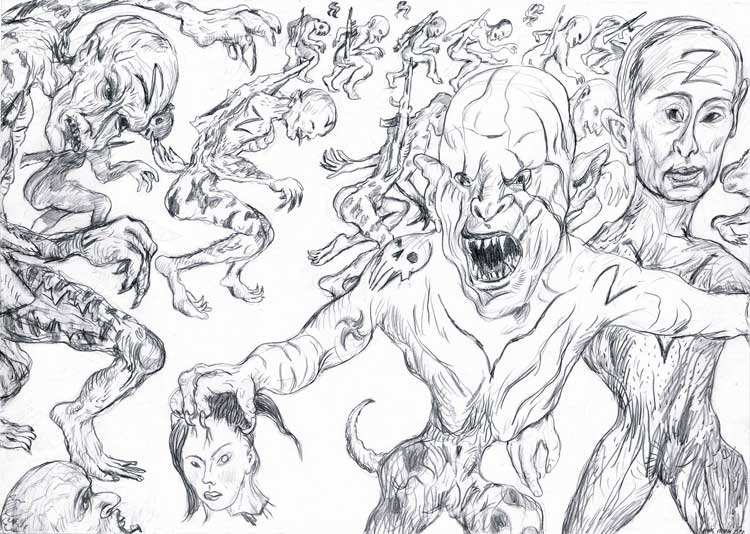
George Gittoes, The Defiler, 2022. Pencil on paper, 84 x 60 cm. A triptych of three drawings. © the artist.
Hellen and I made the instant decision to travel to Kyiv in the first week after the invasion. At the time, the media were predicting the long convoys of Russian tanks and soldiers would be able to take the city within days. We got to Przemysł, near the Polish border, only to find that trains into Ukraine had been cancelled. The station was filled with refugees, mainly women, children and the elderly and numerous pets in carry cages. I made my first drawings showing the despair and fatigue on their faces. I had an instinct we could still travel and I went exploring. I found a country train that was on a separate line to the main railway. There was a moment as we boarded, late at night, when we realised there was no turning back and we felt fear in the pits of our stomachs. This train was almost empty and took us to Lviv, from where we caught a bigger train into Kyiv.
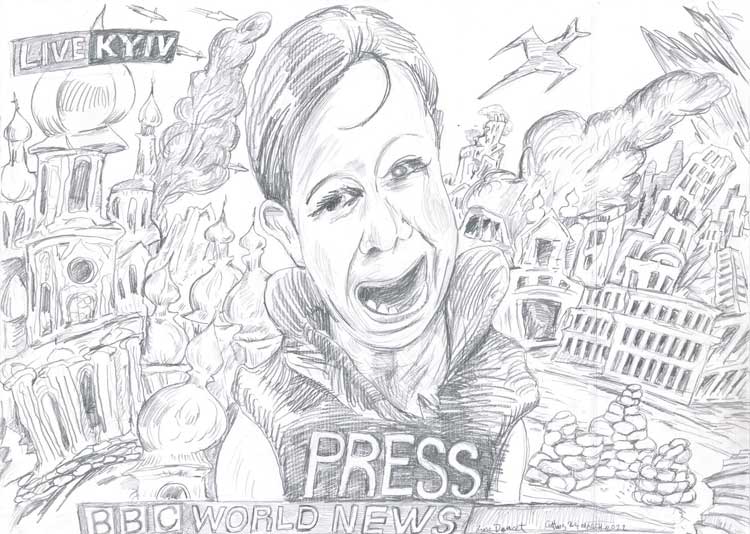
George Gittoes, World News, Ukraine, 2022. Pencil on paper, 84 x 60 cm. © the artist.
We knew nobody there. Hellen had booked a hotel, which was next to Maidan [Independence Square], where the people’s revolution for Independence from Russia occurred in 2013. We were the only guests in the hotel and the city was deserted, with no one moving outside and limited food supplies available from a small underground supermarket. There were tank traps on every corner and young soldiers guarding them. We made friends with these soldiers who told us that they were not regular army but came from many other professions, from IT programmers to civil engineers. It was winter with some snow. Hellen would send me down to them with hot soup and coffee. We imagined that any day there would be Russian tanks and street fighting similar to what we had seen in old black and white archival footage from the second world war. We had no idea what we would do if we had to face an occupying Russian force.

George Gittoes, House of Culture, 2022. Acrylic and oil on canvas, 184 x 250 cm. © the artist.
JMcK: What happened to the Central House of Culture in Irpin?
GG: The Central House of Culture in Irpin was one of the first cultural institutions to be targeted in the early days of the invasion, hit by multiple rocket attacks, tank rounds and mortars. Putin wants to deny that Ukraine has its own independent culture and is attempting to erase cultural centres throughout the country. We knew of this and made it our priority to go there as soon as the Russians began retreating. We found the building completely gutted, paintings and grand pianos turned to ash, littered with unexploded ordinance. We contacted our Ukrainian artist friends to prepare exhibitions and performances within the ruins to prove that the spirit of art cannot be suppressed by such barbarity.
JMcK: How did you conceive the mural Kiss of Death on the wall of The House of Culture?
GG: Since my first meeting with the Ukrainian artist Ave Libertatemaveamor, in April 2022, she and I have created a new drawing every day and shared them via the internet or in person. Like Banksy, Ave uses a false name and hides her face from cameras in order not to reveal her true identity. She brought out the surrealist in me, insisting that we work as much as possible from the subconscious. The mural was to be a high point in our collaboration. We were excited to combine elements of our drawings into a major composition for the outside of the symbolic building. On this, an amplified scale, the local population could feel that art was coming back, like a phoenix out of the destruction.
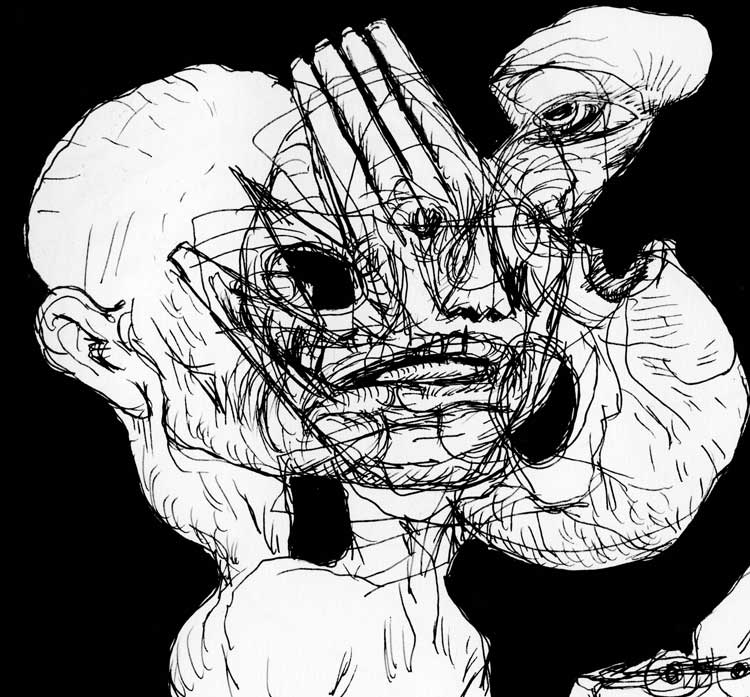
George Gittoes, Kiss of Death, 2022. Ink drawing, 14.8 x 21 cm. © the artist.
JMcK: How was the final composition achieved?
GG: Ave and I struggled for weeks to make an entirely new composition. Eventually, I conceived the mural design using my Warhouse drawing with Ave’s Flexible Woman drawings on either side, plus smaller elements to bind the images. When I showed Ave the composition, she was delighted with it, and we agreed on the title Kiss of Death. It was a relief to meld images intrinsic to both of us. The young artist team of Sasha Kirikhov, Artem Rudenko and Marycia Prus helped me to paint most of it on to the wall of the Central House of Culture. It took a night and two long days using industrial-quality enamel paint. People from the destroyed surrounding houses came to watch, telling us that this was a good start to restoring things to the way they were. Since then, Ave has given birth to a baby girl, Penelope, and joined us towards the end to improve the brushwork and add detail on her sections while her baby snuggled in a pouch on her chest.

George Gittoes with Eva and Warhouse mural in progress, the Central House of Culture, Irpin. 2023. © the artist.
JMcK: It has been very well received?
GG: Everyone who sees it immediately says Guernica, since it is in black and white, very graphic and similar in size and proportion. The actual drawing, composition and figurative subject elements are nothing like Guernica, but we enjoy hearing this. Young people think it is very cool and the manufacturer of skateboards in Ukraine has asked for permission to reproduce it. Recently, buses have begun bringing people to visit the most war-damaged places. Since our murals and those by Banksy have been well publicised in Ukraine, the guides on the buses have made them a feature of the journey and stop off to see them, as well as other works we’ve made at Irpin Bridge, Borodyanka and Bear Mountain Park. It has become an extensive outdoor show of Gittoes, Ave and Banksy!
Unlike Guernica, and situated within the community of Irpin, Kiss of Death does not show distraught humans and animals as casualties of war. This would have been very disturbing. This war is the product of the megalomania of Putin. To normal people, his actions are incomprehensible. His partnership with Alina Kabaeva is a sensitive issue with Putin, who has warned journalists never to mention it. Kabaeva is much younger than Putin and is referred to as the “most flexible woman in Russia”; she is a retired Olympic medal-winning rhythmic gymnast. The painting is a product of Ave’s and my meditation on his corrupt and twisted, psychopathic behaviour and his choice of a young contortionist as his sexual partner. Appointed by Putin to run the Kremlin’s suppressive media monopoly, Kabaeva is not an innocent party.
JMcK: Can you describe the mural Russian Offensive in Odessa, for which you collaborated with local poet Viktor Solodchuk, in which Putin is portrayed as a bloodthirsty warlord from The Hobbit?
GG: The Hobbit and Lord of the Rings were showing on Netflix, Ukraine at the start of the war, making everyone see the comparison. Tolkien wrote the trilogy at the time of Hitler’s Nazi assault on Europe – the comparison has had renewed life now that Putin is behaving similarly to a Dark Lord. The plan to show Putin and the Russian forces in this way was Viktor’s idea and the mural is a visual realisation of a poem he had written in the first weeks of the war.
-copy.jpg)
George Gittoes, Dead Russian, 2022. Acrylic on canvas, 184 x 250 cm. © the artist.
I have become cautious about comparing Russian soldiers to Orcs, when many of the soldiers are forced into service against their will and brainwashed by Putin’s propaganda. I do see Putin as a Dark Lord, but many Russian soldiers are innocents, unaware of the motives of their superiors, especially Putin, and not in control of their own destinies. My painting Dead Russian is a meditation on this. What I did take from that mural and the discussions with Viktor was the concept of the needle, which is a well-known evil-defeating symbol in Ukrainian folk stories. The search for the needle is the search to find a way to defeat the Dark Lord. Viktor explains this in the film and the theme was taken up in the drawings of Ave and myself. We like to think that art can be the needle. The symbolism of the needle bridges and joins the collaborations with Ave and Viktor. Hellen used one of Viktor’s poems in her performance piece.
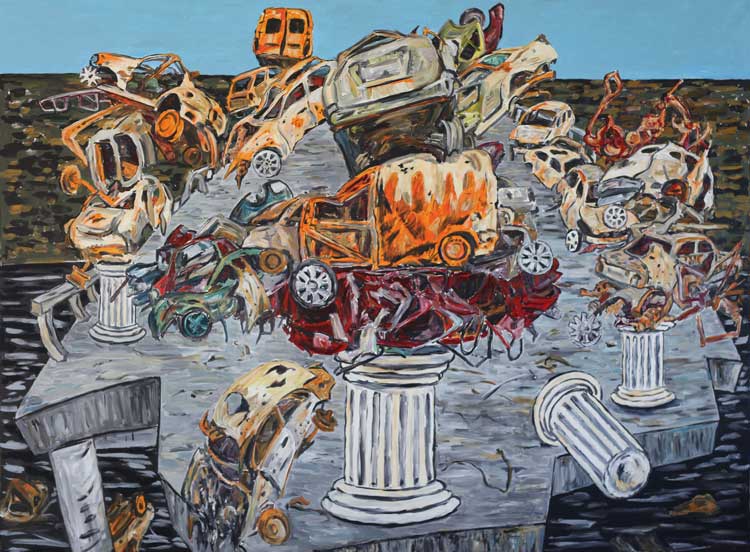
George Gittoes, Victory Triptych, Bridge of Death, 2022. Acrylic on canvas, 184 x 250 cm. © the artist.
JMcK: You have a knack for creating images that fix an atrocity to the “cultural moment”.
GG: Chance has placed me at the centre of some of the worst atrocities, such as the Kibeho massacre in Rwanda in 1995 and the Hebron massacre in Palestine in 1994. In Ukraine, it was first Borodyanka, where we arrived as the Russians were retreating; second, the destroyed Russian tanks at Bucha; and, third, the Bridge of Death in Irpin. The Russian toy bear, stuffed with explosives as a booby trap at Borodyanka; the small child’s party dress, also at Borodyanka, and the dead farmer; and “Punisher Palace” on the outskirts of Borodyanka, all became metaphors. There followed the cars on the destroyed bridge at Irpin, with families slaughtered inside. I had hoped never to experience anything like the Kibeho massacre, where thousands of internal displaced Rwandan refugees were slaughtered with machetes, but the massacre on Irpin Bridge took me back to that horror.
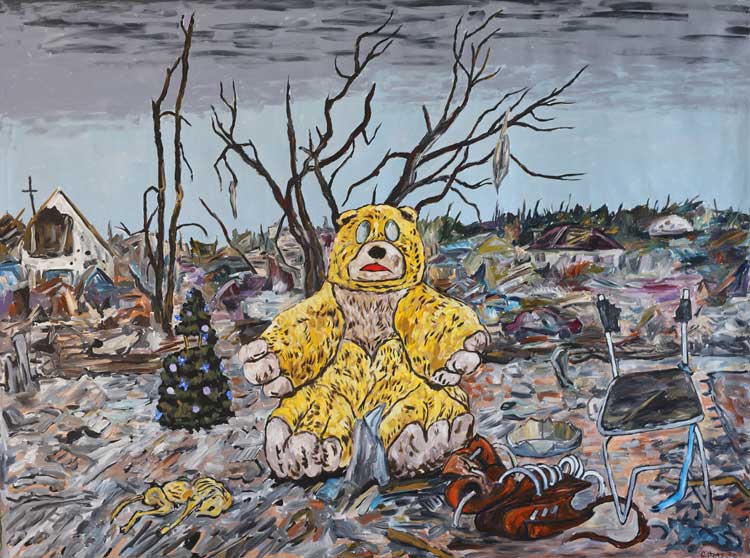
George Gittoes, Victory Triptych, Russian Bear, 2022. Acrylic on canvas, 184 x 250 cm. © the artist.
JMcK: Who are your assistants and how did you meet them and harness their talents and commitment?
GG: In the first period in Ukraine, it was Kate Purunova and Oleksandr Solodkyi. Both found me. Kate noticed Hellen’s posts on social media and contacted us wanting to be of assistance, and Oleksandr (Alex) met me when I was drawing the dead Russian in the tank at Bucha. He is an IT specialist, and his wife is an artist who fled with their daughter to the Netherlands when the war started. Alex lives in Irpin and was keen to be part of the regeneration of the Central House of Culture. He assisted us with every aspect from the physical work of turning the place back into a workable environment to using the cameras for the film. He has been a great help in the second phase as well as the first. Kate became our driver and second camera operator. She explains her role well in the film.
JMcK: You have spoken already about the impact of war on families, the destruction of their homes, the loss of life and terrible injuries. Can you explain how you came to be involved in the pet rescues there?
GG: Before she worked with us, as an animal lover, Kate was a volunteer in helping to save pets after their owners were forced to flee as refugees. There were more homeless wandering dogs and cats in those early days, on the streets, than people. Organisations sprang up to help and Kate was in contact with them. She heard that there were dogs in distress at a dog shelter in Borodyanka and got permission for us to join the group who were travelling there to see what help could be given. This experience was filmed and used in the final film.
The one-hour journey took five hours, and when we arrived there was fighting still going on. The animal rescuers belong to an organisation called STAR and were led by some British ex-soldiers who are dedicated to assisting animals. One of them – Tom – explained that animals were the best cure for the post-traumatic stress disorder that he suffered as a consequence of fighting in Helmand Province in Afghanistan.
At the time of accompanying the pet rescue, we were unaware that we had travelled to Borodyanka prior to it becoming fully liberated by Ukraine forces, and that we were well ahead of the international press. The devastation we witnessed in the city was heartbreaking. Being the first to arrive, ahead of the media, happened a lot while we were in Ukraine as we did not go to press conferences or seek the help of Ukrainian official press organisers. Kate being a local resident made this possible. We stayed away from the international journalist press corps, as we did not want to be influenced by their hype and agendas. Often, I would be in the car with Kate, and I would have a dog or cat on my knee that needed saving and we would pull up at one of the many road blocks and not be asked for ID or passport because I looked like an eccentric Ukrainian grandfather with his young niece or daughter saving a family pet. This enabled us to pass into areas where the press would not be allowed to enter.
Being among the first to witness the carnage at the Irpin Bridge of death came about because Kate’s grandmother lived in Irpin and needed rescuing. It was the first time Hellen had experienced wartime death on a large scale. It was particularly terrible seeing dead children and babies. I worried as it was such a traumatic experience, but Hellen came through it bravely and helped with the filming.
For the second phase of the project (beginning 11 April 2023), we met a young couple, 26-year-old artists Artem Rudenko and Marysia Prus at an art store when buying painting supplies. Artem volunteered to translate for me at the store and we became friends. He later introduced me to his close friend and fellow artist Sasha Kirikhov. They regarded me as a welcome mentor and teacher and were invaluable in everything we did from camera operating to painting Kiss of Death at Irpin House of Art.
Artem, Sasha and Marysia were critical of the fact that the only outdoor street art being done through the war was tagging with graffiti – big spray paint names in different forms of bubble writing, but nothing that addressed the war. They wanted to get out on to the streets and paint images about the war, but as fine artists were too inhibited to do this. By assisting me to do my wall paintings, they lost this inhibition and were grateful. I worked beside them when they designed their first outdoor street paintings. Now, they feel free and hope this will encourage more artists to express feelings about the war and replace the tagging graffiti with relevant and powerful art.

George Gittoes, Russian Monster mural, Borodyanka, 2023, adjacent to Judo mural by Banksy. © the artist.
My first large wall painting one was at Borodyanka. When I approached the building, I had decided to do it on, I was surprised to find a Banksy in an enclosed structure that had been built to protect it. The locals were angry that this had been constructed when they were homeless and sleeping rough without shelter. A security firm had been commissioned to protect the Banksy works after a crew of thieves had cut one from a wall and been arrested. The Borodyanka Banksy – which is of a small child wearing a judo kit throwing a grown man, also in judo kit and identifiable as Putin, on to his back – is popular enough to have been reproduced on a postage stamp.
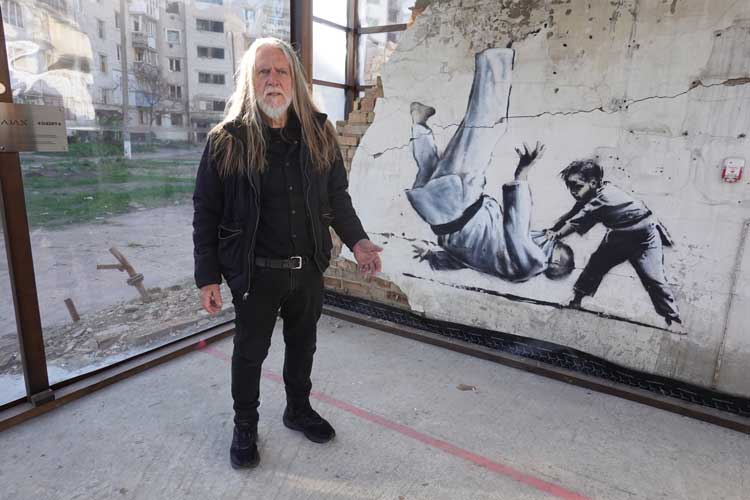
George Gittoes with mural by Banksy, Borodyanka, 2023.
The other Banksy works now have strong metal frames placed over them, with bulletproof glass. One is controversial as it is of an acrobatic gymnast identified with Russian culture and not Ukrainian culture. Both our works and Banksy’s have been publicised on local Ukrainian media, and consequently people go searching for both like an extended outdoor exhibition.
JMcK: You have employed sophisticated imagery with numerous art historical references, in your murals. How have they been received?
GG: I always have the approach that art is difficult enough for people to understand without consciously making it more difficult. I use every means at my disposal to create bridges of understanding between the viewers and the art.
In Ukraine, it was easy because my subjects were of things that the people there were experiencing and sharing. The people of Irpin, for example, immediately understood the Bridge of Death painting and the people of Borodyanka had all seen the Child’s Party Dress and knew how the parents had put it on the window to signal to the Russians that children were inside and then a rocket was aimed, deliberately into their room. Same with the Russian Bear, which was placed theatrically for everyone to see as a symbol of Russian supremacy as they left the city in ruins. They booby-trapped the bear so that it would remain smirking defiantly until a squad of bomb disposal people could disarm it. People thanked me for doing the work and showing support from someone as far away as Australia. They did not feel forgotten or neglected by people in other countries due to our very visible presence and support. This is different from the way that people soon became annoyed and irritated by the international press, who they began to see like vultures pecking at their wounds. We do not wear press body armour or helmets, and we appear like any local civilians. We fitted in and the act of creating – with me painting and Hellen singing – opened people’s hearts to us.
When we returned the second time, we felt a deeper empathy and needed to find new ways to express this. While working with Ave, I did a drawing titled Small Island. It seemed out of place and not to fit with the others. It had popped out of my subconscious and although I did not understand it, it was everyone’s favourite, including Hellen’s. On our return, I realised it represented the way families are forced to huddle together when there are air raids and missile attacks. They become a small island of love – holding on to one another and waiting until the danger passes. Their brothers, fathers and sons that are off fighting, are constantly on their minds. It did not worry anyone that the figures on the island were mermaids. When I painted it on a wall, below some steps in a park, passersby all came and thanked me. It has become my most successful work in Ukraine in terms of public reaction.
It takes time to come into tune with those living through a war. The future is completely uncertain. No one can plan anything until the war ends. Awareness of this drives Hellen and I to push ourselves past exhaustion when we are in Ukraine and use our abilities to the maximum.
The painting that I am now working on back in Australia is entitled Wreck of Hope, after the painting by David Caspar Friedrich. It is based on the terrible experience of the Russian massacre of civilians on the Irpin Bridge, after it had been blown up by Ukraine forces, to prevent the Russian entry into Kyiv in March 2022. It represents the end of the hope the world had in the United Nations to prevent another great war in Europe. When in Ukraine, we feel we are in the third world war. The fighting and everything about it resemble old movies of second world war Europe – it seems like a huge step backwards for humanity.
JMcK: The immediacy of the drawn line enhances the message, providing images that are haunting and with a lasting impact. Have you kept extensive visual diaries while in Ukraine?
GG: I have always kept visual diaries. They are a combination of text and drawing, along with clippings from newspapers and photographs. They are an artist’s witness to the many wars I have experienced in my lifetime. What is different this time is that after meeting Ave, I began to follow her practice of doing at least one black and white ink drawing on small paper 18 x 12.5cm sheets, every day. I have continued this process and exchange the images daily with Ave by scanning them and sending them by email. Ave does the same. It has been the most intense and productive collaboration of my career. She has reminded me of the importance of drawing in a small format. It gives a greater freedom for subconscious expression. When working on larger sheets of paper or canvas, there is an inhibiting factor where the output is taken too seriously.
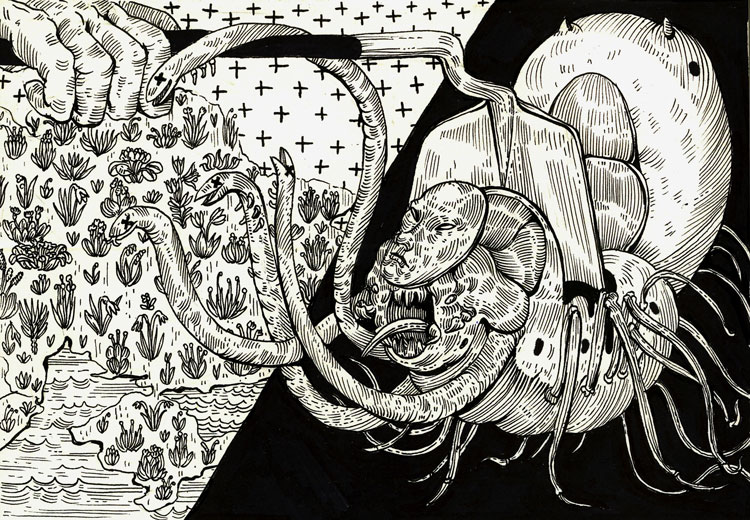
Ave Libertatemaveamor, Insect drawing, 2021. Pen and ink on paper. © the artist.
Working small is like doing a doodle. There are no inhibitions as the amount of material (paper and ink) being expended is trivial. This may seem strange, but it has freed me up to do more drawings that are like those I did when I was much younger and was less restricted by a formal approach to drawing. I regard the small sheets of paper like etching plates (copper or zinc), and it is interesting that with new digital technology they can be scanned and printed to look like etching prints. I am making the prints of our drawings larger than the originals and will be exhibiting them. Ave and I are planning to publish a graphic novel using our drawings without text as a subconscious history of the war. At some point, we will feel we have a complete visual narrative and can take them to a printer. I discovered Ave by seeing prints made from her work and exhibited outdoors in public spaces in Odessa. The curator Vladimir Umamenko had discovered them on Facebook and gained Ave’s permission to show them. When I first saw Ave’s insect drawings I was startled by their connection to my own imagery and knew that I had to find and meet her. Ave’s insect was like my insect images from the Hotel Kennedy Suite, (1968-1971). I have continued to use the insect symbol since. The insect represents people like Putin and Rupert Murdoch who are so unlike the rest of humanity that they are more like alien insects.
JMcK: What are you planning next?
GG: Hellen and I have promised to keep returning to Ukraine until this war ends. This commitment means we are stretched between sustaining our Yellow House activities in Jalalabad, Afghanistan and Ukraine. Our aim is to show that art can win where war fails.
References
1. Art Against War: Australian artists Hellen Rose and George Gittoes in Ukraine, by Chloe Mandryk, A Rich Life, 7 May 2022.
2. George Gittoes, interviewed by the National, 2 April 2010.
3. Letters from Ukraine: 27/07/2022 – Summertime Sadness by Hellen Rose, published in Artist Profile Australia.
4. George Gittoes, email to Janet McKenzie, 28 May 2023.